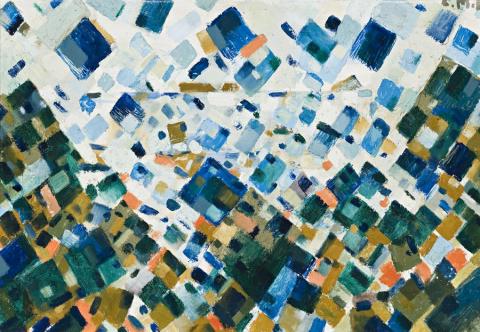FRENCH BAY, 1957
Colin McCahon
oil on board
45.5 x 66.0 cm
signed and dated upper right: C.M. 57
inscribed verso: Colin McCahon / French Bay / oil on hardboard / 1957
Estate of Rodney Kennedy, Dunedin, NZ
Martin Browne Fine Art, Sydney
Private collection, New South Wales
A Private Collection of New Zealand Paintings: Thirty Seven New Zealand Paintings from the Collection of Charles Brash and Rodney Kennedy, Auckland City Art Gallery, Auckland NZ, 1958
Recent Paintings by Colin McCahon, Public Library Lecture Hall, Dunedin, NZ, April 1959, probably cat. 23 (not for sale)
20th Century Australian and New Zealand Painting, Martin Browne Fine Art, Sydney, November 1993, cat. 21
Brown, G.H., Colin McCahon, Artist, A.H. & A.W. Reed Ltd, Wellington NZ, 1984, pp. 59–60
Bloem, M., & Browne, M., Colin McCahon: A Question of Faith, Stedelijk Museum, Amsterdam & Craig Potton Publishing, New Zealand, 2002, pp. 185 (illus. p. 92)
The Colin McCahon Database and Image Library # cm000709
During latter half of 1956 the Manukau Harbour again became the source of inspiration for McCahon's paintings, but this time his interest was restricted to the locality of French Bay. The most noticeable formal elements in the French Bay paintings are the strongly stressed horizontal lines, then the less dominant, shorter, vertical divisions which counter the horizontals. These combine to give form to the landscape: the firm, narrow strip of low-lying hills that edges the distant horizon of the harbour. Above the hills are layers of receding clouds: below, the calm seas and smooth lines of the flowing tide. The other notable factor is the suggestion of atmospheric light as it is absorbed, reflected or bounced off the clouds, the distant hills and the surface of the water. If the semi-geometric construction of the composition imparts a sense of solemnity to the landscape, the cool blues, the browny-greens and flashes of white give an impression of clean, crisp light and sparkling water'
During this period a decisive change affected McCahon's approach to the Titirangi landscape, although it took a while to become fully effective. It started with an increased emphasis on colour as its use relates to atmospheric light. A clearer indication of this change was the way in which the small diamond and square shapes, originally employed to represent the play of light across the surface of objects, began to be used in an abstract manner that went well beyond this surface overlay of reflected light' Because McCahon was to give a dominant role in this series to the effects of light, his descriptive term 'impressionistic style' probably had greater significance than he himself realised at the time. Notwithstanding his use of small squares and oblongs to create the images on which he concentrated with such intensity' his paintings had in their conception become far removed from anything resembling the Cubists' transcription of reality. Indeed, the fragmentation of his imagery into many small units of light and dark shades of colour enhanced the impression of landscapes enveloped in an 'atmospheric' luminosity derived from his exploitation of light as an observed phenomenon. In this respect, he had moved closer to the perceptual spirit of Impressionists such as Claude Monet, if not to the practical method of their pictorial 'impressionism.''1
1. Brown, G., Colin McCahon: Artist, A.H. & A.W. Reed, Wellington, 1984, pp. 57 & 59
VERONICA ANGELATOS
